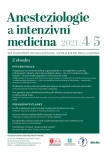Centrální anticholinergní syndrom – zapomenutá diagnóza?
Authors:
J. Málek 1,2
Authors‘ workplace:
Klinika anesteziologie a resuscitace 3. lékařské fakulty Univerzity Karlovy a Fakultní nemocnice Královské Vinohrady, Praha
1; Komise pro historii ČSARIM JEP
2
Published in:
Anest. intenziv. Med., 32, 2021, č. 4-5, s. 237-239
Category:
Short Communication
Sources
- Vágner J, Votava J, Spálený A. Centrální anticholinergní syndrom - zapomenutá diagnóza. Anest. intenziv. Med. 2021; 32(3): 164–167.
- Pachl J, Roubík K. Základy anesteziologie a resuscitační péče. Karolinum, UK Praha, 2003, s. 84.
- Miller RD. Anesthesia, Churchill Livingston, New York, 1981, s. 558.
- Málek J. Doc. MUDr. Bořivoj Dvořáček, CSc. Anest. intenziv. Med. 2015; 26(1): 46.
- Nickalls RWD, Nickalls EA. The first use of physostigmine in the treatment of atropine poisoning. A translation of Kleinwächter’s paper entitled ‘Observations on the effect of Calabar bean extract as an antidote to atropine poisoning. Anaesthesia 1988; 43: 776–779.
- Kleinwächter L. Beobachtung uber die Wirkung des Calabar‑Extracts gegen Atropin‑Vergiftung. Berliner Klinische Wochenschrift 1864; 369–371.
- Dvořáček B, Rupreht J. Trochu z historie fyzostigminu a navíc v Praze. Anest. Intenziv. Med. 2004; 15(6): 299–302.
- Hess L, Málek J, Schreiberová J. Fyzostigmin a jeho použití v současné anesteziologii a intenzivní medicíně. Anest. intenziv. Med. 2006; 17(6): 287–294.
- Rupreht J, Dworacek B. Central anticholinergic syndrome in anesthetic practice. Acta Anaesthesiol Belg. 1976; 27(2): 45–60. PMID: 1024454.
- Státní ústav kontroly léčiv. Anticholium. Dostupné na: www.sukl.cz.
Labels
Anaesthesiology, Resuscitation and Inten Intensive Care MedicineArticle was published in
Anaesthesiology and Intensive Care Medicine

2021 Issue 4-5
Most read in this issue
- Upper airway and esophageal burn injury
- Pooperační únavový syndrom
- Prophylaxis of venous thromboembolism in critically ill patients
- Methylene blue administration in refractory distributive shock
